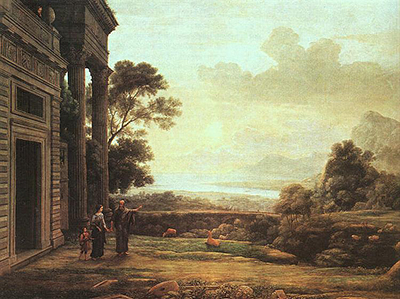The Expulsion of Hagar is a Claude Lorrain painting from 1668. It continued his use of biblical themes within a landscape setting and resides today in the Alte Pinakothek in Munich, Germany.
Within this composition we discover three figures in the foreground, one of whom is a child. They are besides a tall building which is styled in the manner used by Lorrain throughout his career, with classical architecture that fills the majority of the left side vertical of the painting. Some tall trees appear from behind the building and the figures themselves appear to be located within the property's curated garden. As we head into the background the colours naturally get lighter and we move through the perspective. Rolling hills in several layers are placed to the right hand side, with a river cutting past. A bright sky is given nearly half of the canvas, and this was how the artist normally laid out his landscape paintings. A bright sun appears in the distance, centrally within the work, and some large cloud formations appear to the upper right corner. The tones are also entirely typical of the artist and this continues his consistent approach which brought many admirers during his own lifetime and for many centuries after.
The Expulsion of Hagar was completed along with Landscape with Hagar and the Angel at around the same time and both are to be found today at the Alte Pinakothek in Munich, Germany. The item shown here measures 107cm by 140cm and was produced in the standard oil on canvas techniques that dominate most of the artist's career. The two pieces were focused on different times of the day, which brought about variations in atmosphere and this was a topic which greatily interested the artist. Claude was a master of light within art and reached this point by studying and practicing his craft to near obsessive levels. He also captured sunrises and sunsets within other paintings in a manner which had not been seen much before in landscape art up to that point. His influence meant it would now be seen much more frequently in the centuries that followed. Claude used figures normally within the foregrounds of his paintings, but they rarely took much attention from the viewer, even though the title of each piece would often be related directly to them.
Within the biblical tale of The Expulsion of Hagar, we find Abraham banishing Ishmael and his mother, Hagar. They would struggle in the desert of Beersheba and were close to death before being saved by an angel who helped them to replenish their stocks of food and water. The scene of this expulsion, plus another capturing the arrival of the angel, were both seen regularly within Dutch and Italian painting during the 17th century and so were topics which would have been well known to this artist already. He would often be asked to combine his landscape skills with content of a religious or mythological nature by his wide variety of patrons and would always bias his compositions towards the power and beauty of nature, adapting the landscape to even improve upon nature.




